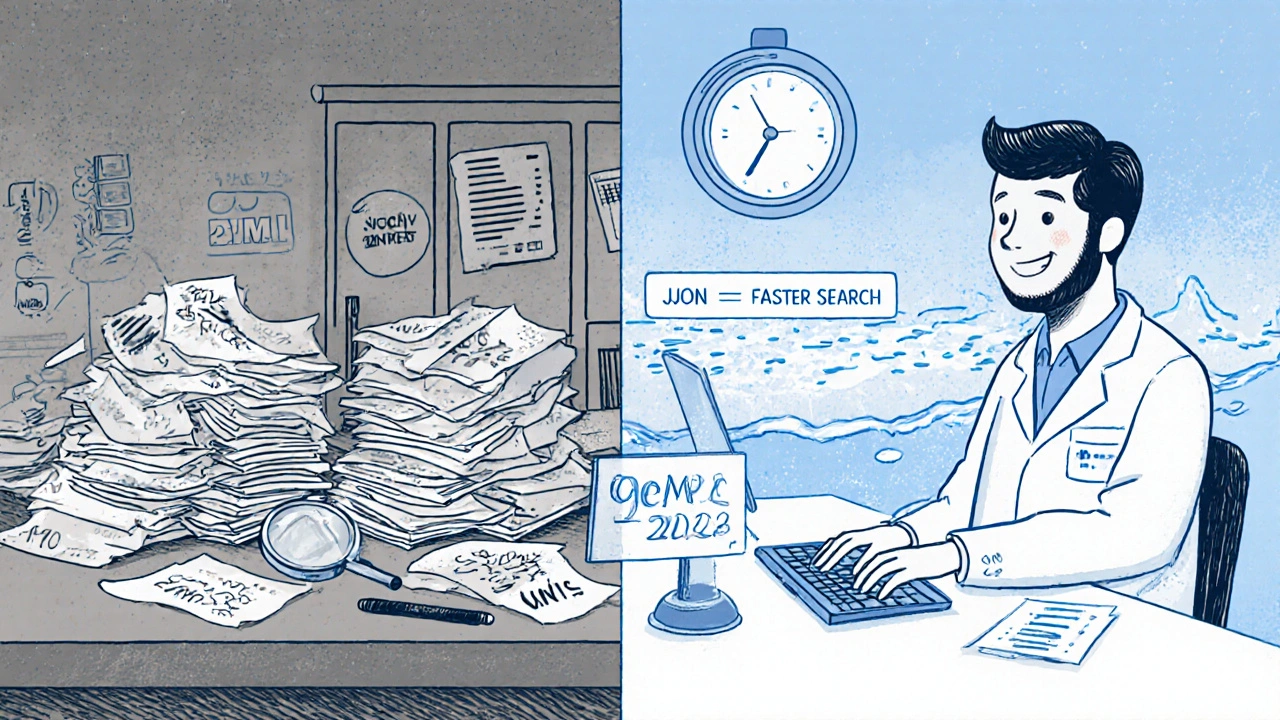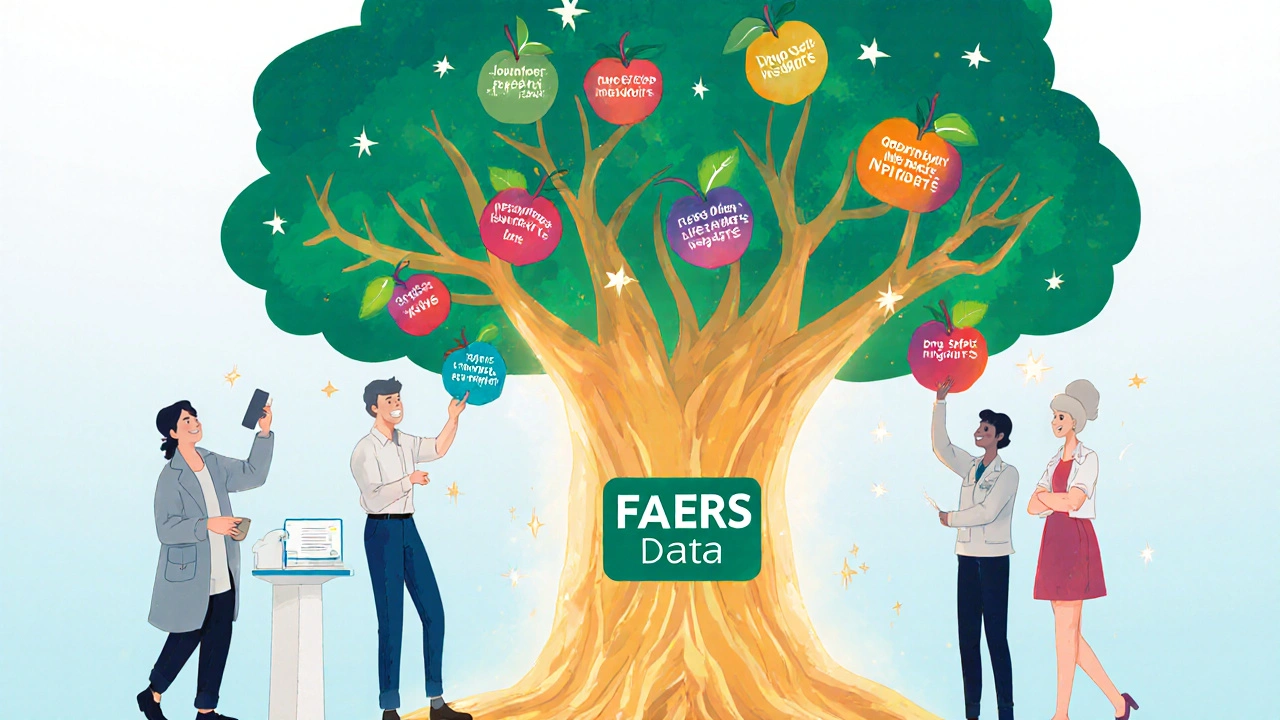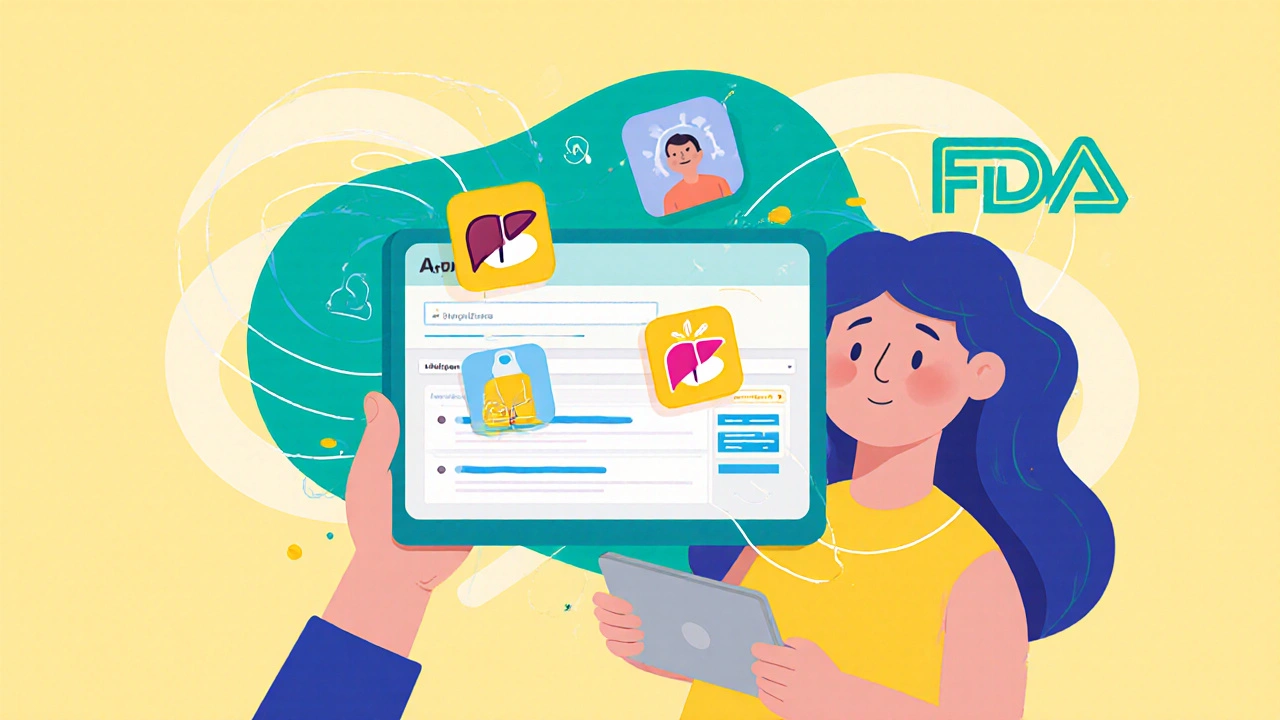OpenFDA Query Builder
Build Your Query
Sample Query
Sample Results (10 reports)
Every year, over 14 million adverse event reports are submitted to the FDA. These aren’t just paperwork-they’re real stories from patients, doctors, and pharmacists about unexpected reactions to medications. But until recently, getting access to this data meant downloading massive XML files, wrestling with outdated formats, and spending weeks just to find what you needed. Today, the OpenFDA API changes all that. It turns the FDA’s hidden treasure trove of drug safety data into something developers, researchers, and even curious patients can actually use.
What OpenFDA and FAERS Actually Are
OpenFDA isn’t a new database. It’s a bridge. The real source of the data is the FDA Adverse Event Reporting System (FAERS), a database that’s been collecting reports of side effects, overdoses, and medication errors since the 1960s. Before OpenFDA, you had to manually download FAERS data in ZIP files, unpack them, and parse XML structures that weren’t built for humans. Most people gave up before they even started. OpenFDA, launched in 2014, took that messy data and turned it into clean, searchable JSON through an API. Think of it like switching from a library’s card catalog to Google Search. Now, instead of digging through boxes, you can type in a drug name and get back structured reports on side effects-within seconds. The API doesn’t just cover drugs. It also includes data on medical devices, food safety incidents, and tobacco products. But if you’re looking at side effects, the drug endpoint is what matters. That’s where you’ll find reports tied to specific medications, patient demographics, symptoms, and outcomes-all coded using MedDRA, the global standard for medical terminology.How the API Works: No Guesswork, Just Queries
You don’t need to be a programmer to use OpenFDA, but you do need to understand how to ask the right question. The API uses Elasticsearch syntax, which is simple once you get the hang of it. Every request goes to one of several endpoints. For drug side effects, you use:https://api.fda.gov/drug/event.json
https://api.fda.gov/drug/event.json?search=openfda.generic_name:ibuprofen
- The generic name of the drug
- The brand name (if reported)
- The patient’s age and gender (de-identified)
- The adverse event term (like "nausea," "liver injury," or "suicidal ideation")
- The outcome: recovered, hospitalized, life-threatening, or fatal
- The date the report was received
You can add filters. Want only reports from 2023? Add &start_date=20230101. Looking for reports where the patient was hospitalized? Add &search=patient.reaction.reactionmeddrapt:"hospitalization".
There’s a catch: you can’t get more than 1,000 results per call. But you can use the skip parameter to page through results. Want reports 1,001 to 2,000? Add &skip=1000 to your next request.
API Keys: Why You Should Get One
You can use OpenFDA without an API key. But you’re limited to 1,000 requests per day. If you’re doing serious research, that’s not enough. Registering for a free API key at open.fda.gov/apis/authentication/ bumps your limit to 120,000 requests per day and 240 per minute. That’s enough for daily monitoring, automated alerts, or building a small tool. The key is simple to use. Just add&api_key=YOUR_KEY_HERE to the end of your URL. No login. No tokens. No OAuth. Just paste it in and go.
Many developers forget this step and hit rate limits. If you see a 429 error, it’s not a bug-it’s the system telling you to slow down or get a key.

What You Can’t Do With OpenFDA
OpenFDA is powerful, but it’s not magic. Here’s what it doesn’t give you:- No patient names or IDs. Privacy is locked down tight. You can’t trace a report back to a person.
- No clinical context. You’ll see that 50 people reported dizziness after taking drug X-but you won’t know if they were elderly, had low blood pressure, or were taking five other meds.
- No signal detection. OpenFDA gives you raw data. It doesn’t tell you if a side effect is statistically significant. Is dizziness rare? Or common? That’s on you to figure out.
- Data is delayed. Reports take time to process. You’re typically looking at data that’s 3 to 6 months old. Real-time monitoring? Not possible.
That’s why OpenFDA isn’t for making medical decisions. The FDA is clear: "Do not rely on openFDA to make decisions regarding medical care. Always speak to your health provider." This tool is for research, trend spotting, and hypothesis building-not diagnosis.
Real-World Uses: Who’s Actually Using This?
You might think this is just for tech teams in labs. But the real impact is wider.- Academic researchers use it to study drug safety trends. Over 350 studies cited OpenFDA data in 2022 alone.
- Patients and advocates built tools like MedWatcher to compare side effects across similar drugs before choosing a treatment.
- Pharmaceutical companies use it to monitor their own products in the wild-catching issues before they become scandals.
- Journalists have used it to uncover patterns in opioid side effects or unexpected reactions to antidepressants.
One 2021 study used OpenFDA to show that certain diabetes drugs were linked to higher reports of pancreatitis than previously known. That data helped trigger a FDA safety review. Without OpenFDA, that pattern might have stayed hidden for years.
Tools and Libraries to Make It Easier
If you’re not coding from scratch, there are tools that handle the API for you.- R package: The
openFDApackage lets you run queries directly in R. Just runset_api_key("your-key-here")and thendrug_events("ibuprofen"). - Python: Use
requeststo call the API, thenpandasto clean the data. A simple script can pull 10,000 reports in under 10 minutes. - Microsoft Power BI: There’s a connector that lets you import OpenFDA data directly into dashboards. No code needed.
GitHub has sample code in Python, Node.js, and R. The FDA even hosts a full open-source repository with setup scripts and data pipelines. If you’re curious how the backend works, it’s built on Elasticsearch, Python (with Luigi), and Node.js-all open-source tools.

Limitations and Ethical Considerations
Just because you can access the data doesn’t mean you should use it carelessly.- Correlation isn’t causation. Just because 200 people reported headaches after taking a drug doesn’t mean the drug caused them. Maybe they were stressed. Maybe they drank more coffee.
- Underreporting is huge. Experts estimate only 1% to 10% of actual side effects are reported. The system relies on voluntary submissions.
- Biases exist. Older adults and hospitalized patients are overrepresented. Young, healthy people rarely report minor side effects.
Using this data responsibly means asking: What’s the full picture? Are there other studies confirming this? Is this a one-off spike or a pattern over years?
What’s Next for OpenFDA?
The FDA is still improving it. In 2023, they expanded device-related endpoints and started cleaning up older data from the 1990s. They’re also working on faster processing to reduce the 3-month delay. The biggest hope? Making it easier to link side effect reports to real-world outcomes-like hospitalizations or deaths-without compromising privacy. If they pull that off, OpenFDA could become the gold standard for post-market drug safety monitoring.For now, it’s the only free, official source of this data. Commercial tools like Oracle Argus or ARTEMIS cost over $150,000 a year. OpenFDA gives you the same raw material-for free.
Getting Started: Your First 5 Steps
1. Go to open.fda.gov/apis/authentication/ and register for a free API key.https://api.fda.gov/drug/event.json?search=openfda.generic_name:metformin&limit=10openFDA package, Python’s requests, or Power BI’s connector.It’s not complicated. It’s not flashy. But it’s one of the most powerful public health tools ever built-and you can use it right now.
Is OpenFDA the same as FAERS?
No. FAERS is the FDA’s raw database of adverse event reports. OpenFDA is the API that makes FAERS data easy to search and use. Think of FAERS as the library and OpenFDA as the search engine.
Can I use OpenFDA to report a side effect?
No. OpenFDA is for accessing existing reports, not submitting new ones. To report a side effect, go to the FDA’s MedWatch portal at fda.gov/medwatch.
How often is the data updated?
New reports are added quarterly. The data you see today is typically 3 to 6 months old. The FDA doesn’t update in real time due to the time needed to review, code, and de-identify each report.
Do I need to know programming to use OpenFDA?
Not necessarily. You can test queries in your browser. Tools like Power BI and R allow you to use the data without writing code. But to build custom tools or analyze large datasets, basic programming skills help.
Is OpenFDA data reliable?
It’s accurate in structure but incomplete in coverage. Every report is verified for basic accuracy, but many go unreported. It’s best used to spot patterns over time-not to judge individual risk.
Can I use OpenFDA data in my research paper?
Yes. Thousands of peer-reviewed studies have used OpenFDA data. Just cite it properly: "Data were obtained from the OpenFDA API (https://open.fda.gov/), a public resource of the U.S. Food and Drug Administration."
What if I hit the API limit?
If you get a 429 error, you’ve exceeded your request limit. Wait an hour or register for a free API key to raise your limit to 120,000 requests per day. Always include your key in requests to avoid hitting limits.

8 Responses
This is the kind of tool that should be taught in high school biology class
Imagine if every kid knew how to dig into real data instead of just memorizing textbook facts
I used it last month to check why my cousin's antidepressant made her dizzy
Turns out it was in the top 5 reactions for that drug
My doctor had no idea
OpenFDA isn't just for nerds it's for anyone who wants to stop being lied to by pharma ads
Why are we still trusting doctors who don't even check this stuff
It's insane
Of course you can’t use this for medical decisions… because the FDA says so. But you can use it to prove your doctor is an idiot. And that’s what matters.
Also: '1% to 10% of side effects are reported'? That’s not underreporting. That’s a national scandal.
And you're telling me people don’t know how to use Elasticsearch? Bro. It’s Google. You type. You get results. Stop pretending this is rocket science.
Also: 120,000 requests per day? That’s not a limit. That’s a dare.
openFDA is lit fr
like who even uses xml anymore
also the fact that you can get 10k reports in 10 mins with python is wild
i tried to use it to see if my weed gummies cause anxiety (they do)
but the data is like 6 months old so i had to wait
still cooler than my dr just saying 'it's prob stress'
also the api key thing is so easy why do people not do it
429 error = you're not trying hard enough
Love seeing this kind of transparency in healthcare
It’s rare to have a government tool this powerful and this easy to use
If you’re just starting out, try searching your favorite supplement or OTC painkiller
You’ll be shocked at what pops up
And don’t be afraid to play around with the filters
Even if you don’t code, Power BI makes it feel like magic
This isn’t just data-it’s empowerment
Keep asking questions. The system wants you to.
OMG I JUST FOUND OUT MY ANTIHISTAMINE CAUSES HEART PALPITATIONS??
I’ve been taking this for 5 years and no one ever told me
Now I get why I felt like I was gonna die every time I took it
My doctor is gonna get a text
Also why is this not on every pharmacy label??
This is the most important thing I’ve learned since I found out my cat hates cucumbers
Someone needs to make a TikTok about this
I think this is so important because a lot of people don’t realize how much we rely on guesswork in medicine
Like we take pills and hope for the best and if something bad happens we just think it’s bad luck
But this shows us patterns
Like if ten people in a row report the same weird symptom after taking a drug
That’s not coincidence
That’s a signal
And even if it’s not proven yet
It’s still worth paying attention to
Also the fact that it’s free
That’s huge
Because most health tools cost money
And if you don’t have money you’re left in the dark
This changes that
Just ran my first query: 'lisinopril' + 'cough'
Over 12,000 reports in 2023 alone
My grandma had that cough for 2 years
No one ever connected the dots
This is why we need more people using this
Not just researchers
Patients. Families. Nurses. Teachers.
If you care about health
Learn this
Now
Why are you even using this? It's useless without clinical context
People will panic over 50 reports of nausea
But if 10 million people take the drug
That's 0.0005%
And you think that's dangerous?
You're not a scientist
You're just scared
Stop spreading fear
Go back to your yoga